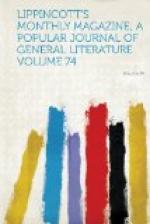“With these lamps the pressure of the gas-current is of great importance; and I now turn to that subject. It is a general complaint in buildings whose rooms are high that the flow of gas on the lower floor is deficient, while on the upper floors there is a greater supply than is necessary. This inconvenience arises from the upper stories being subjected to less atmospheric pressure than the lower, every rise of ten feet making a difference in the pressure of about one-tenth of an inch of water; and, consequently, a column of gas acquires that amount of pressure additional. The following table, recording an experiment of Mr. Richards, will show the result in respect to light:
Gas issuing from the burner at a pressure of— 1/10 inch of water gave the light of 12 candles, 5/10 " " " " " " " 6 " 10/10 " " " " " " " 2 " 40/10 " " " " no appreciable light.
Suppose a building of six floors is supplied from the gas-mains at a pressure of six-tenths, and that the difference of altitude between the highest and lowest light is equal to fifty feet: the gas in the highest or sixth floor will issue from the burners at a pressure of eleven-tenths; the fifth floor, at ten-tenths; and so on. In order to secure an entirely equable flow and economical light a regulator is necessary on each floor above the first. The gas companies are frequently obliged to supply mills at a much greater pressure than is stated above as necessary, in order that the ground floors may have sufficient light.”
“How about incorrect meters?” asked the traveller.
“Little need be said of them, as they fall within the domain of the companies and the public inspector of gas. Under favorable conditions gas-meters will remain in order for ten years or more; and when they become defective they as often favor the consumer, probably, as they do the gas company. Their defects do not often occasion inconvenience; and when they once get out of order they run so wild that their condition is soon detected, when the errors in previous bills should be corrected by estimate of other seasons.”




